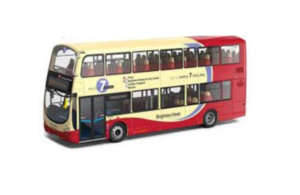Reduced bus emissions and improved air quality in Brighton & Hove
Urban air quality can be improved with a combination of new bus procurements and exhaust retrofits.

Image of a Brighton bus
Summary
Since 2013 Brighton & Hove City Council has targeted government grants to roll out cleaner less polluting vehicle fleets. On the busiest bus lanes, this has helped to deliver a 25% reduction in roadside nitrogen dioxide and a 3µg/m3 reduction in roadside levels of Particulate Matter (PM2.5).
Background
Over recent decades the Brighton-Worthing-Littlehampton agglomeration has shown above-UK-average growth in population and transport demand. Per head, Brighton has the highest bus use in the UK outside of London. Bus services run every few minutes day and night. Public and private investment in cleaner buses and taxis with steady repeated urban mileage is a key to improve local air quality and health.
Brighton & Hove City Council has statutory duty to assess and improve air quality in its local area. This can be achieved through behavioural change to more sustainable forms of travel, avoiding emissions at source and a close working relationship across several public transport operators.
What was involved?
Since 2013 the City Council has targeted government grants to roll out cleaner less polluting vehicle fleets. Limited allocation has been directed at the most frequent vehicles operating in busy areas where ambient air quality exceeds set standards for the protection of human health.
Maps and graphs of the local air quality situation are shared with bus operators and submitted in support of grants applications aimed at a reduction in emissions across the public service fleet.
The following initiatives have been taken:
- 2014 and 2016 exhaust retrofit of 73 double deck buses and 22 taxi minibuses
- 2015 to 2018 procurement of 82 brand new double-deck buses
- progressive conversion of single deck buses to electric operation
Selective Catalytic Reduction Technology fitted to vehicle exhaust combines diesel particulate traps with dosing of add-blue solution to destroy oxides of nitrogen (NOx) before the gas can be emitted to the local atmosphere. Challenges involve keeping exhaust temperatures hot enough for an affective reaction with the ad-blue mixture.
Next generation procurement uses micro-hybrid technology for high passenger capacity double deck buses. Vehicle evolution has moved on to smaller hotter engines combined with regenerative braking and exhaust temperature-control to destroy pollution.
What worked well?
The City Council provided local evidence on where improvements needed to be prioritised. The bus operators identified routes suitable for exhaust retrofits or new vehicle replacements. Funding for cleaner public transport has been approved where patronage is high and it is more effective at reducing emissions in pollution hotspots compared to car scrappage schemes. Projects were delivered swiftly utilising the expertise of engineers specialising in exhaust retrofit.
NOx sensor tests on the vehicle tailpipe indicated that the pollutant reduced by 72% on average. This allowed buses originally at the euro-III emission standard to attain the euro-VI emissions standard. The 2016 and 2017 new buses also surpass the euro-VI emission standard.
The work has helped the city council to upgrade the 2013 low emission zone to an ultralow emissions zone for buses.
On the busiest bus lanes since 2012 this has helped to deliver a 25% reduction in roadside nitrogen dioxide and a 3µg/m3 reduction in roadside levels of Particulate Matter (PM2.5 - particles that are less than 2.5 µm in diameter).
What could be improved?
Some intermediate age buses that are now several years old have been operating since before the project improvements set out above. These vehicles, about a third of the local fleet, require emission performance improvements in order to continue the improving trend in city centre air quality and help comply with all air quality assessment levels throughout the agglomeration. Further improvement is required because a slight increase in NO2 adjacent to the bus lane (North Street) was recorded during 2017.
Next steps
Further funds are required to accelerate emissions improvements:
- seek funded opportunities to facilitate electric minibuses and taxis replacing and phasing out diesel
- seek opportunities to avoid or reduce emissions on major (long term) construction sites with developer contributions and conditions on Construction Environment Management Plans (CEMP)
- for example, conditions for HGV (Heavy Goods Vehicle) emission standards working on the 10 year reconstruction of the Royal Sussex County Hospital Teaching, Trauma & Tertiary Care Units
- include low emission requirements as part of the established permit scheme for roadworks
- monitor progress with emission standards of HGV haulage shuttling between Shoreham port and the hinterland
- educational awareness campaigns working with local schools in the vicinity of Air Quality Management Areas, focused on active travel and avoiding emissions
- for example, vehicle anti-idling to cut emissions when in queuing traffic, waiting for pick up, using hand held devices or on the school run
Further information
Link to Brighton & Hove City Council’s Annual Status Reports on air quality
Samuel Rouse, Senior Scientist Air Quality Officer, Transport and Environmental Protection, Brighton and Hove City Council.